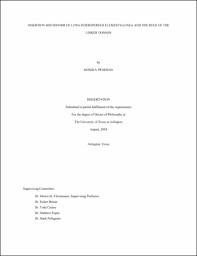
ATTENTION: The works hosted here are being migrated to a new repository that will consolidate resources, improve discoverability, and better show UTA's research impact on the global community. We will update authors as the migration progresses. Please see MavMatrix for more information.
Show simple item record
| dc.contributor.advisor | Christensen, Shawn | |
| dc.creator | Pradhan, Monika | |
| dc.date.accessioned | 2020-08-04T18:25:01Z | |
| dc.date.available | 2020-08-04T18:25:01Z | |
| dc.date.created | 2018-08 | |
| dc.date.issued | 2018-08-27 | |
| dc.date.submitted | August 2018 | |
| dc.identifier.uri | http://hdl.handle.net/10106/29328 | |
| dc.description.abstract | Long Interspersed Elements (LINEs), also known as non-Long Terminal Repeat (non-LTR) retrotransposons are major group of transposable elements ubiquitous in eukaryotic genomes and are known to altogether influence the structure and function of the host genome. LINEs encode a multifunctional protein that reverse transcribes its mRNA to DNA at the insertion site by a process called Target Primed Reverse Transcription (TPRT) which involves two half reactions involving DNA cleavage followed by DNA synthesis. TPRT is the first half of the integration reaction. The second half of LINE integration, second strand cleavage and second strand synthesis, has remained poorly understood. Also, poorly understood is the role of the nearly universally conserved linker domain of the LINE encoded protein. The unknown aspects of the integration mechanism and the protein domains were studied in vitro by using a site-specific R2 LINE from Bombyx mori (R2Bm). A Holiday junction-like 4-way target DNA structure was identified to be an essential integration intermediate and the gateway into the second half of the integration reaction. The 4-way junction cleaved at the proper second-strand cleavage site and upon cleavage created a primer-template that led to second-strand DNA synthesis. The Linker region of the R2 protein was found to be important for recognizing the 4-way junction and for positioning the DNA relative to the endonuclease and reverse transcriptase active sites. The linker region is located just after the reverse transcriptase and harbors a conserved set of predicted α-helices, thought to be an α-finger, followed by a gag-like zinc knuckle. In addition to binding and positioning the 4-way junction, the α-finger residues were found to control target DNA cleavages and new strand synthesis at every step of the integration mechanism. The zinc knuckle residues also showed similar function but were more prominent for the second half of integration. Finally, the role of specific residues in the N-terminal RT-1 region and the endonuclease R-box region were also explored. A unique residue has been identified in the RT-1 region that is able to distinguish between 3' PBM RNA and 5' PBM RNA. The endonuclease R-box region appeared to be important for second strand DNA cleavage. | |
| dc.format.mimetype | application/pdf | |
| dc.language.iso | en_US | |
| dc.subject | Long Interspersed Elements (LINEs) | |
| dc.subject | non-Long Terminal Repeat Retrotransposons | |
| dc.subject | Target-primed reverse transcription | |
| dc.subject | Linker domain | |
| dc.subject | R2 | |
| dc.title | Insertion Mechanism of Long Interspersed Elements (LINEs) and the role of the Linker Domain | |
| dc.type | Thesis | |
| dc.degree.department | Biology | |
| dc.degree.name | Doctor of Philosophy in Quantative Biology | |
| dc.date.updated | 2020-08-04T18:25:02Z | |
| thesis.degree.department | Biology | |
| thesis.degree.grantor | The University of Texas at Arlington | |
| thesis.degree.level | Doctoral | |
| thesis.degree.name | Doctor of Philosophy in Quantative Biology | |
| dc.type.material | text | |
Files in this item
- Name:
- PRADHAN-DISSERTATION-2018.pdf
- Size:
- 99.81Mb
- Format:
- PDF
This item appears in the following Collection(s)
Show simple item record


